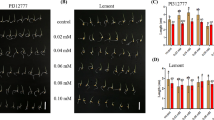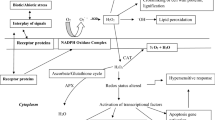Abstract
Treatment of read canary grass leaves with phenol, 4-chlorophenol, naphthalic anhydride and phenylethylisothiocyanate increased glutathione S-transferase activity by 1.4–2.4-fold (control 17 U g−1 DW). Benzothiadiazole, β-aminobutyric acid and salicylic acid increased activity by 1.3–1.8-fold. Total glutathione pool was increased by the toxic compounds by 1.2–2-fold and by the elicitors 1.4–1.6-fold (control 593 nmol g−1 DW). Unlike the other compounds, benzothiadiazole and salicylic acid did not decrease the redox state. Benzothiadiazole acted synergistically with chlorophenol on glutathione S-transferase and glutathione levels and counteracted the decrease in redox state caused by the xenobiotic. Reed canary grass thus has a strong potential to neutralize toxic compounds, which may be further enhanced by elicitors.
Similar content being viewed by others
References
Q Chaudhry P Schröder D Werck-Reichhart W Grajek R Marecik (2002) ArticleTitleProspects and limitations of phytoremediadion for the removal of persistent pesticides in the environment Environ. Sci. Pollut. Res 9 4–17
JOD Coleman MMA Blake-Kalff TG Emyr Davies (1997) ArticleTitleDetoxification of xenobiotics by plants: chemical modification and vacuolar compartmentation Trends. Plant Sci 2 144–151 Occurrence Handle10.1016/S1360-1385(97)01019-4
R Edwards DP Dixon (2004) ArticleTitleMetabolism of natural and xenobiotic substrates by the plant glutathione S-transferase superfamily Ecological Studies 170 17–50
JW Fahey AT Zalcmann P Talalay (2001) ArticleTitleThe chemical diversity and distribution of glucosinolates and isothiocyanates among plants Phytochemistry 56 5–51 Occurrence Handle10.1016/S0031-9422(00)00316-2 Occurrence Handle11198818
OW Griffith (1980) ArticleTitleDetermination of glutathione and glutathione disulfide using glutathione reductase and 2-vinylpyridine Anal. Biochem 106 207–212 Occurrence Handle10.1016/0003-2697(80)90139-6 Occurrence Handle7416462
OC Knörzer B Lederer J Durner P Böger (1999) ArticleTitleAntioxidative defense activation in soybean cells Physiol. Plant 107 294–302 Occurrence Handle10.1034/j.1399-3054.1999.100306.x
F Navari-Izzo R Izzo (1994) ArticleTitleInduction of enzyme activities and antioxidant production in barley plants as a result of SO2 fumigation Plant Sci 96 31–40 Occurrence Handle10.1016/0168-9452(94)90219-4
M Oostendorp W Kunz B Dietrich T Staub (2001) ArticleTitleInduced disease resistance in plants by chemicals Eur. J. Plant Pathol 107 19–28 Occurrence Handle10.1023/A:1008760518772
S Pascal R Scalla (1999) ArticleTitlePurification and characterization of a safener-induced glutathione S-transferase from wheat (Triticum aestivum) Physiol. Plant 106 17–27 Occurrence Handle10.1034/j.1399-3054.1999.106103.x
A Schäffner B Messner C Langebartels H Sandermann (2002) ArticleTitleGenes and enzymes for in-planta phytoremediation of air, water and soil Acta Biotechnol 22 141–152 Occurrence Handle10.1002/1521-3846(200205)22:1/2<141::AID-ABIO141>3.0.CO;2-7
P Schröder C Collins (2002) ArticleTitleConjugating Enzymes involved in xenobiotic metabolism of organic xenobiotics in plants Int. J. Phytoremed 4 247–265
T Tausz H Šircelj D Grill (2004) ArticleTitleThe glutathione system as a stress marker in plant ecophysiology: is a stress–response concept valid? J. Exp. Bot 55 1955–1962 Occurrence Handle10.1093/jxb/erh194 Occurrence Handle15234995
Author information
Authors and Affiliations
Corresponding author
Rights and permissions
About this article
Cite this article
Urbanek, H., Majorowicz, H., Zalewski, M. et al. Induction of Glutathione S-Transferase and Lutathione by Toxic Compounds and Elicitors in Reed Canary Grass. Biotechnol Lett 27, 911–914 (2005). https://doi.org/10.1007/s10529-005-7181-9
Received:
Revised:
Accepted:
Issue Date:
DOI: https://doi.org/10.1007/s10529-005-7181-9




